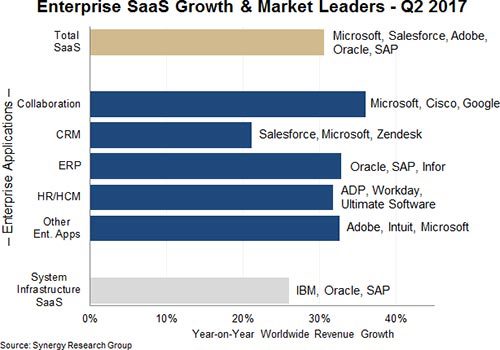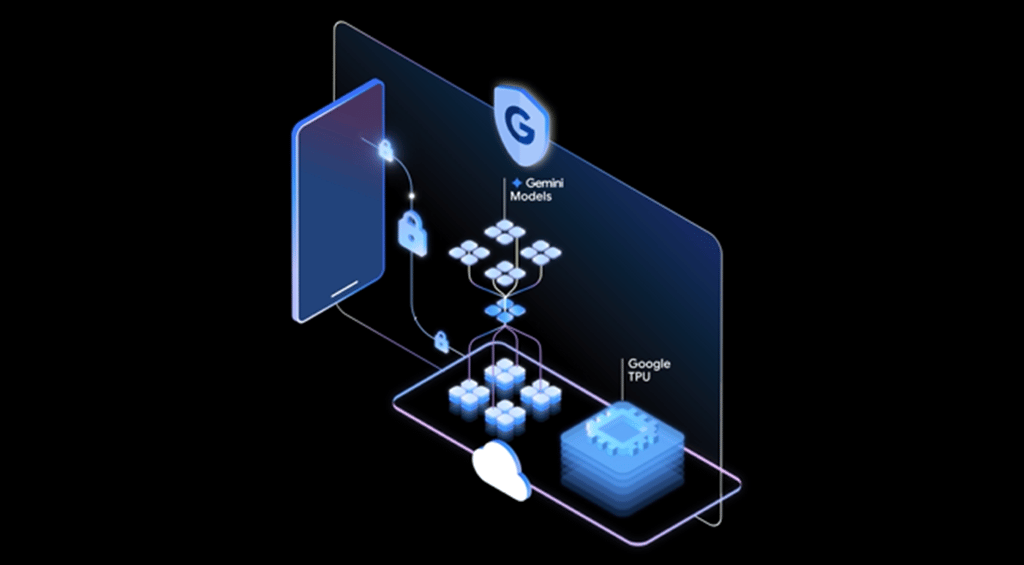Software-as-a-service (SaaS) companies generated nearly $15 billion in the second quarter (Q2) of 2017, an annual increase of 31 percent, according to the latest report released today by Synergy Research Group. Microsoft continues to lead the market, having surpassed cloud customer relationship management (CRM) giant Salesforce last year. A mammoth acquisition later, and the Redmond, […]
Datamation content and product recommendations are
editorially independent. We may make money when you click on links
to our partners.
Learn More
Software-as-a-service (SaaS) companies generated nearly $15 billion in the second quarter (Q2) of 2017, an annual increase of 31 percent, according to the latest report released today by Synergy Research Group.
Microsoft continues to lead the market, having surpassed cloud customer relationship management (CRM) giant Salesforce last year. A mammoth acquisition later, and the Redmond, Wash. software maker and cloud provider is pulling ahead at a brisk pace.
Cloud Storage and Backup Benefits
Protecting your company’s data is critical. Cloud storage with automated backup is scalable, flexible and provides peace of mind. Cobalt Iron’s enterprise-grade backup and recovery solution is known for its hands-free automation and reliability, at a lower cost. Cloud backup that just works.
SCHEDULE FREE CONSULT/DEMO
“Helped by the LinkedIn acquisition, Microsoft further distanced itself from the chasing pack of SaaS providers. Long-time market leader Salesforce was overtaken by Microsoft a year ago but remains the number two player,” said John Dinsdale, chief analyst and research director at Synergy Research Group.

“These two are followed by Adobe, Oracle and SAP,” continued Dinsdale. “The fastest growing major SaaS providers are Oracle, Microsoft and Google.”
The collaboration segment of the market is growing the quickest, he added. And Microsoft is in a good position to capitalize on this trend.
In recent years, the company has been sprinkling collaboration capabilities onto its cloud-enabled productivity software suite, Office 365. In March, Microsoft released Teams, the company’s answer to Slack, a popular group chat collaboration platform.
Naturally, Microsoft Teams is tightly integrated with the rest of the Office 365 ecosystem, allowing users to quickly pull Office-based content and communications into their chat sessions.
“The Office 365 applications and services that people use every day—including Word, Excel, PowerPoint, OneNote, SharePoint and Power BI—are built into Microsoft Teams, giving people the information and tools they need,” announced Kirk Koenigsbauer, in a blog post announcing the general availability of Microsoft Teams earlier this year. “We’ve recently added support for open, public teams within an organization. We’ve also enhanced the meeting experience by adding scheduling capabilities, integrating free/busy calendar availability for team members, adding recurrence, and making it easier to transition from chat to high-quality voice and video.”
The market remains highly fragmented but it doesn’t appear to matter much, at least in terms of overall growth. Synergy expects SaaS providers to double their revenues within the next three years, Dinsdale said, which spells good news for the market as a whole.
Microsoft, Salesforce and the aforementioned companies aside, other leading SaaS providers include ADP, Cisco, IBM, Intuit, ServiceNow and Workday. The latter two companies, along with other “born-in-the-cloud” vendors are credited with keeping the industry on its toes and helping spur enterprise demand for SaaS solutions by Synergy.
Pedro Hernandez is a contributing editor at Datamation. Follow him on Twitter @ecoINSITE.
-
Huawei’s AI Update: Things Are Moving Faster Than We Think
FEATURE | By Rob Enderle,
December 04, 2020
-
Keeping Machine Learning Algorithms Honest in the ‘Ethics-First’ Era
ARTIFICIAL INTELLIGENCE | By Guest Author,
November 18, 2020
-
Key Trends in Chatbots and RPA
FEATURE | By Guest Author,
November 10, 2020
-
Top 10 AIOps Companies
FEATURE | By Samuel Greengard,
November 05, 2020
-
What is Text Analysis?
ARTIFICIAL INTELLIGENCE | By Guest Author,
November 02, 2020
-
How Intel’s Work With Autonomous Cars Could Redefine General Purpose AI
ARTIFICIAL INTELLIGENCE | By Rob Enderle,
October 29, 2020
-
Dell Technologies World: Weaving Together Human And Machine Interaction For AI And Robotics
ARTIFICIAL INTELLIGENCE | By Rob Enderle,
October 23, 2020
-
The Super Moderator, or How IBM Project Debater Could Save Social Media
FEATURE | By Rob Enderle,
October 16, 2020
-
Top 10 Chatbot Platforms
FEATURE | By Cynthia Harvey,
October 07, 2020
-
Finding a Career Path in AI
ARTIFICIAL INTELLIGENCE | By Guest Author,
October 05, 2020
-
CIOs Discuss the Promise of AI and Data Science
FEATURE | By Guest Author,
September 25, 2020
-
Microsoft Is Building An AI Product That Could Predict The Future
FEATURE | By Rob Enderle,
September 25, 2020
-
Top 10 Machine Learning Companies 2020
FEATURE | By Cynthia Harvey,
September 22, 2020
-
NVIDIA and ARM: Massively Changing The AI Landscape
ARTIFICIAL INTELLIGENCE | By Rob Enderle,
September 18, 2020
-
Continuous Intelligence: Expert Discussion [Video and Podcast]
ARTIFICIAL INTELLIGENCE | By James Maguire,
September 14, 2020
-
Artificial Intelligence: Governance and Ethics [Video]
ARTIFICIAL INTELLIGENCE | By James Maguire,
September 13, 2020
-
IBM Watson At The US Open: Showcasing The Power Of A Mature Enterprise-Class AI
FEATURE | By Rob Enderle,
September 11, 2020
-
Artificial Intelligence: Perception vs. Reality
FEATURE | By James Maguire,
September 09, 2020
-
Anticipating The Coming Wave Of AI Enhanced PCs
FEATURE | By Rob Enderle,
September 05, 2020
-
The Critical Nature Of IBM’s NLP (Natural Language Processing) Effort
ARTIFICIAL INTELLIGENCE | By Rob Enderle,
August 14, 2020
SEE ALL
CLOUD ARTICLES










